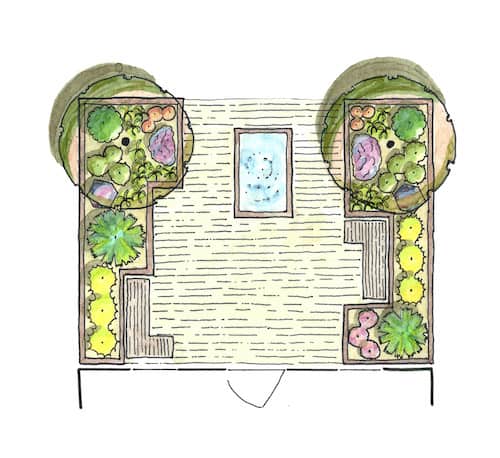All design, whether in the landscape, on a canvas or in a magazine, draws upon common tools of composition. These elements of design include mass, form, line, texture and color. In the landscape, they are used to transform space and create a unique experience.
While color and texture add interest and richness to a design, it is mass, form and line that are critical to organizing space and providing structure. Understanding these key design elements is the first step in creating a harmonious, unified landscape.


Two similar designs for a patio garden can be used to explore the elements of design. The rectilinear design (top left) and angular design (top right) provide the same function and visual connection to the surrounding landscape.
Line
Line is used to carry the eye through a landscape and to create physical flow and connectivity. Vertical lines carry the eye skyward and are useful in expanding small spaces. Strong horizontal lines can make a space feel broader. Lines also elicit emotional responses: straight lines are formal and direct, while curved lines are more gentle and natural.
Consider line when shaping beds and walkways, or in choosing hardscape elements such as fences. Visualize how a straight or curved line might direct the eye through the landscape toward a focal point.

In both designs the primary line of site is toward the central focal point. Perceived lines in the rectilinear design carry the eye in one direction, while the protruding points in the angular design slow the eye’s movement.
Mass
In design, mass is a measure of visual size. Mass describes the space or area occupied by an object or group of objects. A planting bed, house, patio and arbor all have mass, as do individual plants in a garden.
The objective in design is to balance the mass of objects in the landscape. Individual components should be sized according to their surroundings. For example, planting beds are sized in relation to the adjacent lawn, house or hardscape. Likewise, the mass of individual plants or groups of plants within a bed need to occupy a space proportionate to the overall planting.

The mass of open space (void) and filled space is balanced in both designs. Likewise, the central fountain which serves as a focal point, is appropriately-sized for its surroundings.
Form
Form refers to the shapes of objects in a landscape. Many forms exist in a landscape such as the rectilinear shapes of the house, walkways and driveways. Plants, topography and hardscape delineate other forms that may include squares, circles, triangles or irregular shapes.
Plants also have individual form ranging from pyramidal to rounded, vase-like to flat or spreading. When plants are placed into groups, they take on a new form as a group which may be quite distinct from the individual shape.
Landscape forms evoke emotions and create ambiance. Rectilinear forms feel structured and formal, circles are soft, triangles are strong, and irregular shapes are casual and free. We can take advantage of form in a design to set the mood of a landscape.

The rectilinear design has a formal, orderly feel while the angular design is more relaxed. When designing landscape form strive to complement the style of the house.
Voids
Empty spaces or voids also “fill” a distinct area and contain visual mass. Voids also encompass a particular space or form in the landscape. When designing, empty space is more important than occupied space. The voids in a landscape serve to balance and unite individual components.
Too often, lawns, patios, or other voids are composed of leftover space. A more effective approach is to intentionally design the voids. When laying out bed lines or establishing new hardscape elements, try designing the empty space rather than the occupied. Planting beds, hardscape and focal points will fall into place around these intentional spaces.






